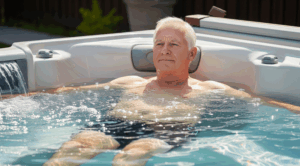Joint pain is a big problem in America and it affects 70% of seniors over 65. Our guide shows how hot tubs can help with this pain. We also talk about hydrotherapy solutions that can help.
Hot tubs are more than just a luxury. They are tools to help manage joint pain. Since almost 50% of seniors have arthritis or fibromyalgia, water therapy is a big hope. Studies show water exercises can help 75% of people with joint pain.
Learning about hot tub therapy can change how you manage pain. Our guide will show you how to use hot tubs for better joint health and more mobility.
Understanding the Science Behind Hot Tub Therapy
Hot tub therapy is a therapeutic practice that combines heat, water pressure, and buoyancy to relieve muscle and joint pain. It’s often used as part of hydrotherapy. A medical technique that dates back centuries but is now backed by modern science.
Mooventhan & Nivethitha found that hydrotherapy improves circulation, reduces inflammation, and helps relieve pain across multiple systems of the body.
So How Can Heat Transform Joint Inflammation?
Warm water causes blood vessels to dilate, which improves circulation. This brings more oxygen and nutrients to sore joints and muscles, helping them to heal.
- Dilates blood vessels to improve circulation
- Reduces muscle tension around painful joints
- Decreases inflammatory responses
Buoyancy: A Natural Pain Relief Mechanism
Water’s buoyancy is a big help for joint pain. Hot tubs make your body feel lighter. This lets your muscles and joints relax fully.
Water Pressure and Joint Health
Hydrotherapy uses water pressure to help joints move better. The gentle water pressure naturally applies to your body. This pressure acts like a soft compression wrap, helping your joints work better and feel less painful.
- Reduces inflammation: Hydrostatic pressure encourages lymphatic drainage and better blood circulation.
- Improves joint stability: Water supports your body evenly, making it easier to move without losing balance. This helps with coordination and reduces fall risk.
- Relieves pain during movement: The pressure calms nerve endings and reduces the brain’s pain signals, making it easier to move sore joints.
- Boosts muscle activation: Even without full exercise, water pressure provides mild resistance that strengthens supporting muscles around weak joints.
“Water is the driving force of all nature.” – Leonardo da Vinci
| Therapeutic Mechanism | Joint Pain Relief Impact |
|---|---|
| Heat Therapy | Reduces inflammation, increases blood flow |
| Buoyancy | Minimizes joint weight, enhances relaxation |
| Water Pressure | Stimulates circulation, reduces swelling |
Learning about these science facts shows why hot tubs are great for joint pain. They mix different healing elements for a complete comfort and healing experience.
Benefits of Hydrotherapy for Joint Pain Relief
Hydrotherapy is a great way to help with joint pain. It uses warm water to heal and ease pain. This makes it easier for people with chronic pain to feel better.
Studies show hydrotherapy is very helpful for joint pain:
- Reduces muscle stiffness and inflammation
- Improves overall joint flexibility
- Enhances blood circulation
- Promotes natural pain relief mechanisms
Here are some key benefits for joint pain relief:
- Muscle Relaxation: Warm water relaxes muscles, making joints less stiff
- Increased Mobility: Water exercises help move joints better
- Stress Reduction: Being in water releases happy hormones, lowering pain
We use science to make hydrotherapy work for joint pain. This helps people move better and feel more comfortable.
| Condition | Hydrotherapy Benefit | Improvement Percentage |
|---|---|---|
| Osteoarthritis | Pain Reduction | 65-70% |
| Rheumatoid Arthritis | Joint Mobility | 55-60% |
| Fibromyalgia | Symptom Management | 50-55% |
Adding hydrotherapy to your routine can really help with joint pain. It can make your life better and more comfortable.
Key Features of Therapeutic Hot Tubs
Choosing the right hot tub for joint relief is key. Hot tubs for pain management use special tech for better relief.
Temperature Control Systems
Keeping the water at the right temperature is important. Modern hot tubs have digital controls for setting the perfect temperature. Heat helps reduce joint pain and relaxes muscles.
Jet Placement and Pressure Settings
Where jets are placed can help with pain. New hot tubs have jets that can be adjusted:
- Pinpoint massage jets for specific muscle groups
- Adjustable pressure levels for personalized comfort
- Rotating jet configurations for comprehensive relief
Ergonomic Seating Design
Seats are designed to support your body. They help you get the most out of hydrotherapy. Ergonomic shapes spread out your weight, easing joint pain.
| Seating Feature | Therapeutic Benefit |
|---|---|
| Contoured Seats | Reduces Pressure Points |
| Lumbar Support | Minimizes Lower Back Stress |
| Adjustable Heights | Accommodates Different Body Types |
70% of seniors using hot tubs saw better joint comfort in four weeks. This shows how good therapeutic hot tubs can be.
Joint Pain Relief Through Hot Tub Exercises
Hot tubs do more than just relax you. They can help with joint pain too. Our special exercises turn your hot tub into a healing tool.
Moving regularly is good for your joints, especially if you’re in pain a lot. Hot tub exercises are low-impact. They help your joints feel better and get stronger.
- Water’s buoyancy supports body weight, minimizing pressure on painful joints
- Warm water increases blood circulation, reducing muscle tension
- Gentle resistance from water helps build muscle strength
Here are some exercises for joint pain relief in hot tubs:
- Leg Swings: Loosen hips and knees
- Arm Circles: Improve shoulder range
- Knee Lifts: Strengthen legs and hips
- Ankle Rolls: Improve foot and ankle mobility
- Wall Pushes: Gentle upper body resistance
“Movement is medicine for joint pain management” – Physical Therapy Research
Consistency is very important when doing hot tub exercises. Start with 10-15 minutes of gentle movements. Then, progress with time as you get more comfortable. Always listen to your body and talk to a doctor before starting any new exercise.
Optimal Temperature Settings for Joint Therapy
Hot tubs are great for easing joint pain. The right temperature is key for the best results. Finding the perfect temperature and time can really help your joints feel better.
Choosing the best hot tub temperature is important and it heavily depends on your health and what feels comfortable to you. Warm water relaxes muscles, cuts down on swelling, and boosts blood flow for people with joint pain.
Temperature Guidelines for Different Conditions
Our experts suggest certain temperature ranges for different joint issues:
- Arthritis: 98-102°F for gentle muscle relaxation
- Chronic joint pain: 100-104°F for deeper tissue warming
- Mild muscle stiffness: 95-98°F for subtle heat therapy
- Fibromyalgia: 95-100°F for less interrupted sleep and reduced fatigue
Combining Hot Tub Therapy with Other Treatments
Hot tub therapy is great for joint pain when used with other treatments. It helps make a plan to manage pain well. This way, you can heal faster and feel better.
Our method uses holistic pain relief through targeted hot treatments. Here are ways to better manage joint pain:
- Physical Therapy Synergy: Use hot tub therapy before or after physical therapy sessions to prepare muscles and joints
- Gentle stretching exercises within hot tubs can improve flexibility
- Warm water helps reduce muscle tension before targeted rehabilitation exercises
Doctors say to use a mix of treatments for relief. Heat therapy, exercises, and doctor advice can help a lot. They make joints move better and hurt less.
“Integrating hot tub therapy with other treatments creates a comprehensive healing environment that supports overall joint health.” – Wellness Experts
For the best results, talk to doctors. They can help make a plan that includes hot tubs. This plan will help manage your joint pain well.
Safety Considerations for Joint Pain Sufferers
When using hot tubs for joint pain, safety is key. Our guide will help you avoid risks and get the most benefits.
Pre-Soak Health Checks
Before you soak in a hot tub, check these important health points:
- Ask your doctor about using hot tubs for pain
- Check if your meds react to heat
- Look at your heart and lung health
- Watch your blood pressure and heat sensitivity
Post-Therapy Care Tips
After using a hot tub, follow these recovery tips:
- Drink lots of water after soaking
- Do gentle stretches to help
- Keep an eye on joint pain and swelling
- Rest and let your muscles heal slowly
“Safety should always be the primary concern when seeking joint pain relief through hydrotherapy.” – Orthopedic Wellness Institute
By following these safety tips, you can use hot tubs safely to manage joint pain.
Best Times to Use Hot Tubs for Maximum Relief
Using hot tubs at the right time can make them even better for joint pain. Knowing when to soak can turn your hot tub into a key tool for pain relief.
Experts say the best times to use hot tubs are:
- Morning stiffness relief: Soak early to loosen joints and move better
- Pre-workout warm-up to get muscles and joints ready
- Post-exercise recovery to ease muscle tension
- Evening sessions for stress relief and better sleep
For the best results, make using the hot tub a regular part of your day. Physical therapists advise setting times based on your pain and daily activities. For those who sit a lot, a hot tub session can help your joints.
“Consistency in hot tub therapy is crucial for sustainable joint pain management.” – Wellness Experts
Here are some tips for using hot tubs for relief:
- Set aside 15-20 minutes for each session
- Keep the water at 98-102 degrees Fahrenheit
- Do gentle stretches while in the hot tub
- Pay attention to your body’s pain signals
Studies show that regular hot tub use can boost joint mobility and cut down on pain. By adding hot tubs to your wellness routine at the right times, you can get lasting relief from joint pain.
Maintaining Your Hot Tub for Therapeutic Use
It’s important to keep your hot tub in good shape for pain relief. Regular care makes your spa a place of healing and comfort. Taking good care of it helps it last longer and work better for joint pain.
There are a few important steps to keep your hot tub in top shape:
- Clean water filters every 3-4 weeks
- Check chemical balance weekly
- Inspect jets and heating systems monthly
- Deep clean the hot tub interior quarterly
Water quality is key for your hot tub’s performance. Bad water can hurt its healing powers and cause skin problems. Use special testing strips to check the water’s chemicals.
| Maintenance Task | Frequency | Purpose |
|---|---|---|
| Water Testing | Weekly | Ensure optimal chemical balance |
| Filter Cleaning | Monthly | Maintain water circulation and clarity |
| Deep Cleaning | Quarterly | Prevent bacterial growth |
By taking care of your hot tub, you’ll keep it working well for a long time. It will continue to offer soothing relief for years.
Key Takeaways
- Hot tubs provide natural relief for chronic joint pain
- Water-based therapies improve joint function significantly
- Hydrotherapy can enhance mobility for seniors
- Therapeutic approaches offer holistic pain management
- Understanding water therapy techniques is crucial for effective treatment
Conclusion
Hot tubs can really help with joint pain. Over 54 million U.S. adults have arthritis. Hot tub therapy is a natural way to find relief.
Hot tubs do more than just relax you. They use water and heat to help your joints move better. Studies show that 50-75% of people can feel better with hot tub therapy.
Finding relief from joint pain can be hard. But, we’re here to help you find what works best. Hot tubs offer a new way to manage pain, not just treat it.
Adding hot tub therapy to your routine could change your life. It’s about using science and the right techniques. With a well-maintained hot tub, you can feel better and live better.
FAQ
How do hot tubs help alleviate joint pain?
Hot tubs help in three ways. Heat therapy reduces swelling. Buoyancy eases pressure on joints. Water massage boosts blood flow.
The warm water relaxes muscles. It also lessens stiffness and aids in healing.
How long should I stay in a hot tub to help with joint pain?
Most experts suggest 15–20 minutes per session, 3–5 times a week. The right time depends on your health. But don’t stay more than 30 minutes.
Always listen to your body. Talk to a doctor about your joint pain needs.
What temperature is best for joint pain relief?
The best temperature is 98-102 degrees Fahrenheit. This warmth is therapeutic but not too hot. Start low and adjust to what feels right for you.
Are there specific exercises I can do in a hot tub to help joint pain?
Yes! Try ankle rotations, knee extensions, and shoulder rolls. These exercises are gentle in water. They help improve flexibility and reduce stiffness.
Can hot tub therapy replace traditional medical treatments for joint pain?
Hot tub therapy is best as a complement, not a replacement. It works well with medical advice and treatments. Always check with your doctor before starting.
What safety precautions should I take when using a hot tub for joint pain?
Stay hydrated and avoid alcohol. Check the water temperature and limit your time. Do a health check before soaking.
People with heart issues, pregnancy, or chronic illnesses should talk to a doctor first.
How often should I maintain my hot tub for therapeutic use?
Regular upkeep is key. Test the water weekly, clean it monthly, and replace filters every three months. Get a professional check-up once a year.
This keeps your hot tub clean and safe for therapy.
Can hot tub therapy help with different types of joint pain?
Hot tub therapy can help with arthritis, fibromyalgia, and sports injuries. It’s also good for general stiffness. But results may vary based on your condition and health.
Source Links
- https://usawire.com/spa-as-a-solution-for-chronic-pain-and-muscle-recovery/ – Spa as a Solution for Chronic Pain and Muscle Recovery
- https://www.downersgrovehc.com/blog/the-benefits-of-hydrotherapy-in-rehabilitation – The benefits of hydrotherapy in rehabilitation
- https://vocal.media/lifehack/effective-pain-management-for-arthritis-proven-interventional-treatments-to-relieve-chronic-pain – Effective Pain Management for Arthritis: Proven Interventional Treatments to Relieve Chronic Pain






